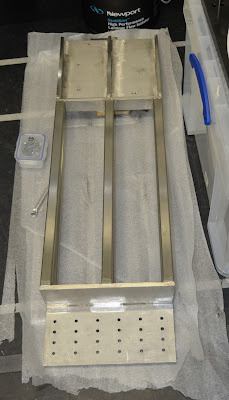The time has come to open up the foil bag & meet our new instrument! But first we had to remove all the Styrostone & the new floor panels so that we could access the tank properly.
Then clean up the spectrometer room & particularly the HRS enclosure as the new flooring & other work in there had generated epic amounts of dirt & styrofoam bits that stick to Everything...
The team demonstrated exceptional domesticity as we first set about cleaning the room & then later turned the vacuum cleaner on ourselves & eventually on each other in the instrument-team equivalent of troop grooming.
Once the area was deemed to be clean & clear, David was charged with cutting the tape.
& then snipping the whole bag open.
Beneath the foil bag was an immensely pleasing amount of high-quality bubble-wrap - Aaaaah :)
Knowing that the tank will need to be covered again before the end of the weekend (when the contractors will return to paint the outside of the HRS enclosure), we elected to preserve the huge foil bag so that we'll be able to re-deploy it when necessary.
Yet more furious unwrapping & then There She Was! Thanks to Eddy for pointing her out to us, & to Ted for explaining that HRS, in fact, stands for Her Royal Spectrographness :)
Fortunately her subjects know exactly how to show their respect! On your knees boys...
Here are the 2 camera ports on the side of the tank.
The telescope-end of the fibres, as well as the various bits for the high-stability mode had been carefully packed at the front of the frame.
Much stretching, crawling & skooching around to undo all the clamps that hold the 3 sections of the tank together....
Everyone was relieved to confirm that the optical bench looked none the worse for wear after the long voyage south.
If the échelle's the heart of the instrument, the optical fibres surely represent the veins. This pic shows where the fibres for the medium & high resolution modes get launched into the fore-optics (which are not yet in place).
These modes (medium & high res, as well as the high-stability mode, employ image-slicing optics which re-package the fibre output faces into a stacked set of vertical slices to yield higher resolutions. This is the input side of the modified Bowen-Walraven type slicer system.
& here's the output side...
Before the red pupil mirror or the collimator mirror could be installed, we had to get the 2 optical bench out-riggers into position at either end of the bench. Below is the part that goes at the collimator end of the tank.
This section goes at the opposite end to support the red pupil mirror.
This is the red pupil mirror going into positon, atop its PI linear stage that will control the red camera's focus.
Despite the day being peppered with looks such as these, Luke assured us that he Really Was having fun!
Next door in the HRS electronics room, Eddy was still coaxing various machines to life.
This is the end of the fibre bundle that will attach to the Fibre Instrument Feed (FIF) up on the SALT payload. The single black cable goes into the "fibre breakout box" & splits into the various individual fibres: the star & sky fibres for each mode, as well as spares for each of these, for a total of 16 fibres.
The tank had to be wheeled part of the way out of the HRS enclosure to permit access so that we'll be able to install the grating & the collimator mirror tomorrow.
After dinner, Eddy appeared with something magical. A truly superb Islay whisky that's known as the peatiest, smokiest, most complex single malt of them all. This Surely deserves to become the official instrument beverage... :)
























No comments:
Post a Comment